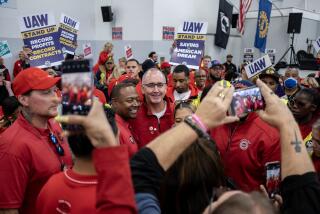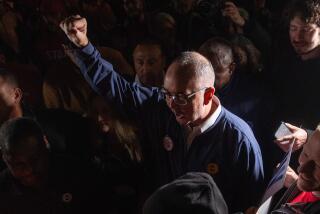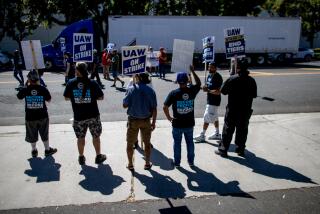Greyhound Sale: Good News or Bad News for Workers?
There are still unexplained coincidences and little mysteries involved in the sale of Greyhound Lines bus operations to a group of Texas investors. Although Greyhound workers may be confused by it all, they just might come out of it a bit better off than they are now.
Even a slim prospect of better days ahead might encourage the workers, who for several years have been taking a beating at the hands of the hard-nosed Greyhound chairman, John W. Teets. After a 47-day strike in 1983, they accepted wage and fringe benefit cuts of 15%. Despite this, nearly 5,000 workers have been laid off since then, and the 9,000 remaining workers have just rejected Teets’ demand that they take yet another 15% reduction.
The optimists among the workers might well theorize that the new owners could hardly be tougher on them than Teets, who sold the profitable 73-year-old bus line, with a book value of about $100 million, for a hefty $350 million just two days before Christmas. And he blamed the workers for the sale, saying he had only done what he had threatened to do if they refused to accept more cuts in their wages and benefits to help increase profits.
The sale was widely regarded by the workers as another bit of evidence that Teets’ real name is Scrooge and that they are headed for more trouble.
There are some signs, however, that the Greyhound deal could prove to be an exception to the general rule that has prevailed in sales and takeovers of corporations in recent years. Usually, workers are forced to pay--sometimes dearly--for the corporate wheeler-dealer maneuvers that often provide substantial benefits to the corporate executives who make the deals.
But things could be different at Greyhound. Hopes for a brighter 1987 for workers at the company rest primarily with Fred G. Currey of Dallas, former chief executive of Trailways bus lines, which is still Greyhound’s chief competitor. He heads the Texas investment group that is buying Greyhound’s bus operations.
The hopes may be slim, since Trailways workers have long earned less than those at Greyhound, even though many of them are represented by the same union. Trailways traditionally earned less money and, probably as a result, managed to negotiate lower-cost labor contracts than Greyhound.
Pessimists in the union could well figure that Currey, the former Trailways executive, isn’t going to agree that Greyhound workers should now get pay raises or even that wages should be kept at present levels, since the Greyhound people are still somewhat ahead of their counterparts at Trailways.
In fact, the new owners might insist on the additional 15% cuts that Teets had demanded. The workers cannot even be sure Currey won’t try to break their unions regardless of the concessions they agree to accept.
But still there are those little mysteries about the Greyhound sale, and some remarks by the new owners, that might have some happy conclusions for Greyhound workers when they are explained.
For instance, after union members rejected Teets’ demand for another 15% pay cut, he proposed that the old contract be extended for 90 days without any wage or benefit cuts. The union leaders agreed but said they first had to get membership approval.
A mail ballot on the proposed extension was started last week and the votes will be counted Jan. 15. If the extension is rejected, another strike could be called immediately.
If the union members accept the proposal, however, the contract extension will not expire until March 17 and there would be no strike, at least until then.
But even while Teets was negotiating with the union to get the contract extension, he was quietly negotiating with Currey to sell the company to the Texas investors, unbeknown to most, if not all, of the union negotiators.
And the sale was sealed even before Teets reached agreement with the union leaders to ask the members for a contract extension. Presumably, Teets wanted the extension to head off a possible strike that could interfere with the sale he had just made to Currey.
The sale is due to be made final March 18, which, probably not by coincidence, is just one day after the proposed union contract extension would expire. In other words, a strike could come only a day after the new owners take over Greyhound, if the present contract is extended.
But Teets’ unpublicized meetings with Currey and still-unexplained corporate maneuvers, buttressed by some remarks from Currey, could still lead the more upbeat Greyhound workers to believe there will be better days for them in 1987. Currey has already had an unpublicized meeting with James LaSala, president of the Amalgamated Transit Union, which represents about 6,000 Greyhound employees. Currey calls it a “good get-acquainted” meeting. LaSala says his goal is to “salvage inter-city bus driving in the United States.”
Next Tuesday, Currey will meet with LaSala, Domenic Sirigano, head of the union’s Greyhound council, and other union leaders “to see what we can do.”
Also encouraging is the fact that, through a spokesman, Currey said he is convinced that Greyhound is understaffed. He already has plans for hiring and training 1,000 new drivers to expand charter and inter-city operations of Greyhound. In contrast, Teets was constantly complaining about the terrible competition of low-cost airlines and inadequate profits and repeatedly telling workers of his plans to reduce bus service more and more.
Currey says he is going to the meetings with the union leaders “with hope that the conversations will lead somewhere. There are all kinds of possibilities.” He didn’t elaborate.
“It is clear we need a full complement of drivers. What has passed is past. (Presumably, he referred to the workers’ fights with Teets.) We are going to start with a clean slate. We have time before the closing of the sale to figure out what can be done.”
These remarks don’t sound like those of a corporate executive out to get massive wage and benefit cuts or to break the unions that have had contracts with Greyhound for more than four decades.
He could be playing some inexplicable game of cat-and-mouse with the workers and their union and may only want to avoid a showdown with them until the sale is made final in mid-March.
He knows the union is badly divided between militants who are ready to strike again to fight off concessions and those who believe another strike will not stop the erosion of jobs.
The workers, and skeptics among the union leaders, have a right to be suspicious of Currey’s vague promises of better days just around the corner. But they didn’t get even those promises from Teets. If they reject the extension, the battle will be joined and their prospects for victory are bleak.
If they accept, there is a chance that Greyhound will once again be a good place to work and its buses good for the public.
Where There’s Smoke
Sometimes there is just no telling to what lengths people will go to keep jobs.
Unions are among the harshest critics of employers who endanger their workers by using asbestos, pesticides and other dangerous substances on farms and in factories and offices. With good cause, they have been denouncing the Reagan Administration for its failure to adequately enforce the nation’s health and safety laws.
Nevertheless, some of the country’s most progressive unions are still actually complaining that Surgeon General C. Everett Koop, and an endless number of reliable scientific studies, are just too tough on the tobacco industry.
The real reason the unions have joined with the tobacco companies in a formal alliance to defend the indefensible weed is obvious: There are well over 30,000 union jobs at stake and most of them might be lost if we finally, rationally, accept as fact the surgeon general’s warnings that tobacco produces dangerous carbon monoxide and can cause lung cancer, heart disease, emphysema and other fatal ailments.
But, like the tobacco companies, the Bakery, Tobacco and Confectionary Workers and a few other unions have joined the Tobacco Labor-Management Committee to dream up a host of flimsy reasons why workers, at least, should not be deterred from smoking by the result of studies made by doctors, scientific researchers and every surgeon general for the last 23 years.
Saving jobs is, indeed, important. But it should be obvious that saving lives is an even more critical task for unions.


